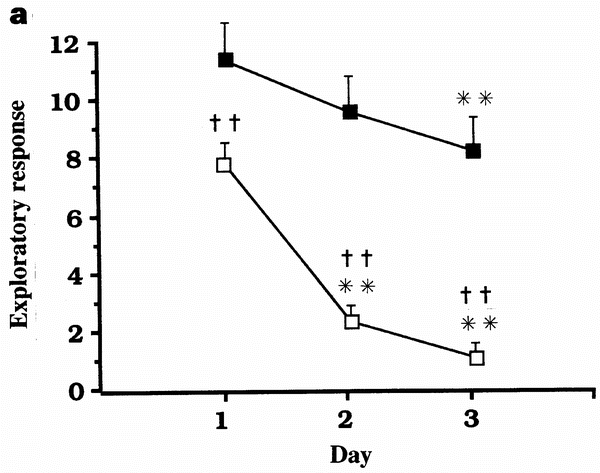
- Select a language for the TTS:
- UK English Female
- UK English Male
- US English Female
- US English Male
- Australian Female
- Australian Male
- Language selected: (auto detect) - EN
Play all audios:
ABSTRACT Dopamine receptors have been implicated in the behavioural response to drugs of abuse. These responses are mediated particularly by the mesolimbic dopaminergic pathway arising in
the ventral tegmental area and projecting to the limbic system. The rewarding properties of opiates1 and the somatic expression of morphine abstinence2 have been related to changes in
mesolimbic dopaminergic activity that could constitute the neural substrate for opioid addiction3. These adaptive responses to repeated morphine administration have been investigated in mice
with a genetic disruption of the dopaminergic D2 receptors4. Although the behavioural expression of morphine withdrawal was unchanged in these mice, a total suppression of morphine
rewarding properties was observed in a place-preference test. This effect is specific to the drug, as mice lacking D2 receptors behaved the same as wild-type mice when food is used as
reward. We conclude that the D2 receptor plays a crucial role in the motivational component of drug addiction. Access through your institution Buy or subscribe This is a preview of
subscription content, access via your institution ACCESS OPTIONS Access through your institution Subscribe to this journal Receive 51 print issues and online access $199.00 per year only
$3.90 per issue Learn more Buy this article * Purchase on SpringerLink * Instant access to full article PDF Buy now Prices may be subject to local taxes which are calculated during checkout
ADDITIONAL ACCESS OPTIONS: * Log in * Learn about institutional subscriptions * Read our FAQs * Contact customer support SIMILAR CONTENT BEING VIEWED BY OTHERS OPIOID-INDUCED
NEUROANATOMICAL, MICROGLIAL AND BEHAVIORAL CHANGES ARE BLOCKED BY SUVOREXANT WITHOUT DIMINISHING OPIOID ANALGESIA Article 09 July 2024 FACILITATING MGLUR4 ACTIVITY REVERSES THE LONG-TERM
DELETERIOUS CONSEQUENCES OF CHRONIC MORPHINE EXPOSURE IN MALE MICE Article 21 December 2020 GENERALIZED CUE REACTIVITY IN RAT DOPAMINE NEURONS AFTER OPIOIDS Article Open access 02 January
2025 REFERENCES * Wise, R. A. & Bozarth, M. A. Apsychomotor stimulant theory of addiction. _Psychol. Rev._ 97, 469–492 (1987). Article Google Scholar * Harris, G. C. & Aston-Jones,
G. Involvement of D2 dopamine receptors in the nucleus accumbens in the opiate withdrawal syndrome. _Nature_ 371, 155–157 (1994). Article ADS CAS Google Scholar * Koob, G. F. Drugs of
abuse: anatomy, pharmacology and function of reward pathways. _Trends Pharmacol. Sci._ 13, 177–184 (1992). Article CAS Google Scholar * Baik, J. H._et al_. Parkinsonian-like locomotor
impairment in mice lacking dopamine D2 receptors. _Nature_ 377, 424–428 (1995). Article ADS CAS Google Scholar * Di Chiara, G. & Imperato, A. Drugs abused by humans preferentially
increase synaptic dopamine concentrations in the mesolimbic system of freely moving rats. _Proc. Natl Acad. Sci. USA_ 85, 5274–5278 (1988). Article ADS CAS Google Scholar * Wise, R. A.
Neurobiology of addiction. _Curr. Opin. Neurobiol._ 6, 243–251 (1996). Article CAS Google Scholar * Bozarth, M. A. & Wise, R. A. Intracranial self-adminsitration of morphine into the
ventral tegmental area in rats. _Life Sci._ 28, 551–555 (1981). Article CAS Google Scholar * Broekkamp, C. L., Phillips, A. S. & Cools, A. R. Facilitation of self-stimulation behavior
following intracerebral microinjections of opioids into the ventral tegmental area. _Pharmacol. Biochem. Behav._ 11, 289–295 (1979). Article CAS Google Scholar * Phillips, A. C. & Le
Piane, E. G. Reinforcing effects of morphine microinjection into the ventral tegmental area. _Pharmacol. Biochem. Behav._ 12, 965–968 (1980). Article CAS Google Scholar * Joyce, E. M.
& Iversen, S. D. The effect of morphine applied locally to mesencephalic dopamine cell bodies on spontaneous motor activity in the rat. _Neurosci. Lett._ 14, 207–212 (1979). Article CAS
Google Scholar * Kalivas, P. W. & Richardson-Carlson, R. Endogenous enkephalin modulation of dopamine neurons in ventral tegmental area. _Am. J. Physiol._ 251, R243–R249 (1986). CAS
PubMed Google Scholar * Ettenberg, A., Pettit, H. O., Bloom, F. E. & Koob, G. F. Heroin and cocaine intravenous self-administration in rats: mediation by separate neural systems.
_Psychopharmacology_ 78, 204–209 (1982). Article CAS Google Scholar * Pettit, H. O., Ettenberg, A., Bloom, F. E. & Koob, G. F. Destruction of dopamine in the nucleus accumbens
selectively attenuates cocaine but not heroin self-administration in rats. _Psychopharmacology_ 84, 167–173 (1984). Article CAS Google Scholar * Borg, P. J. & Taylor, D. A. Voluntary
oral morphine self-administration in rats: effect of haloperidol or ondansetron. _Pharmacol. Biochem. Behav._ 47, 633–646 (1994). Article CAS Google Scholar * Maldonado, R., Stinus, L.,
Gold, L. & Koob, G. F. Role of different brain structures in the expression of the physical morphine withdrawal syndrome. _J. Pharmacol. Exp. Ther._ 261, 669–677 (1992). CAS PubMed
Google Scholar * Bozarth, M. A. Physical dependence produced by central morphine infusions: an anatomical mapping study. _Neurosci. Biobehav. Rev._ 18, 373–383 (1994). Article CAS Google
Scholar * Longoni, R., Spina, L. & Di Chiara Dopaminergic D-1 receptors: essential role in morphine-induced hypermotility. _Psychopharmacology_ 93, 401–402 (1987). Article CAS Google
Scholar * Fournié-Zaluski, M. C._et al_. “Mixed inhibitor-prodrug” as a new approach toward systemically active inhibitors of enkephalin-degrading enzymes. _J. Med. Chem._ 35, 2473–2481
(1992). Article Google Scholar * Kalivas, P. W., Widerlow, E., Stanley, D., Breese, G. & Prange, A. J. Enkephalin action on the mesolimbic system: a dopamine-dependent and a
dopamine-independent increase in locomotor activity. _J. Pharmacol. Exp. Ther._ 227, 229–237 (1983). CAS PubMed Google Scholar * Daugé, V., Rossignol, P. & Roques, B. P. Blockade of
dopamine receptors reverses the behavioral effects of edogenous enkephalins in the nucleus caudatus but not in the nucleus accumbens: differential involvement of delta and mu opioid
receptors. _Psychopharmacology_ 99, 168–175 (1989). Article Google Scholar * Valverde, O., Fournié-Zaluski, M. C., Roques, B. P. & Maldonado, R. The CCKBantagonist PD-134,308
facilitates rewarding effects of endogenous enkephalins but does not induce place preference in rats. _Psychopharmacology_ 123, 119–126 (1995). Article Google Scholar * Salamone, J. D. The
involvement of nucleus accumbens dopamine in appetitive and aversive motivation. _Behav. Brain. Res._ 61, 117–133 (1994). Article CAS Google Scholar * Salamone, J. D. The behavioral
neurochemistry of motivation: methodological and conceptual issues in studies of the dynamic activity of nucleus accumbens dopamine. _J. Neurosci. Methods_ 64, 137–149 (1996). Article CAS
Google Scholar * Matthes, H. W. D._et al_. Loss of morphine-induced analgesia, reward effect and withdrawal symptoms in mice lacking the µ-opioid-receptor gene. _Nature_ 383, 819–823
(1996). Article ADS CAS Google Scholar * Maldonado, R., Negus, S. & Koob, G. F. Precipitation of morphine withdrawal syndrome in rats by administraiton of mu-, delta- and
kappa-selective opioid antagonists. _Neuropharmacology_ 31, 1231–1241 (1992). Article CAS Google Scholar * Spyraki, C., Fibiger, H. C. & Phillips, A. G. Attenuation of heroin reward
in rats by disruption of the mesolimbic dopamine system. _Psychopharmacology_ 79, 278–283 (1983). Article CAS Google Scholar * Mackey, W. B. & van der Kooy, D. Neuroleptics block the
positive reinforcing effects of amphetamine but not of morphine as measured by place conditioning. _Pharmacol. Biochem. Behav._ 22, 101–105 (1985). Article CAS Google Scholar * Stinus,
L._et al_. Chronic flupentixol treatment potentiates the reinforcing properties of systemic heroin administration. _Biol. Psychiat._ 26, 363–371 (1989). Article CAS Google Scholar *
Smith, J. E., Guerin, G. F., Co, C., Barr, T. S. & Lane, J. D. Effects of 6-OHDA lesions of the central medial nucleus accumbens on rat intravenous morphine self-administration.
_Pharmacol. Biochem. Behav._ 23, 843–849 (1985). Article CAS Google Scholar * Elmer, G. I., Pieper, J. O., Goldberg, S. R. & George F. R. Opioid operant self-administration, analgesi,
stimulation and respiratory depression in µ-deficient mice. _Psychopharmacology_ 117, analgesi23–31 (1995). Article CAS Google Scholar Download references ACKNOWLEDGEMENTS We acknowledge
B. Kieffer for the gift of µ-opioid cDNA. A.S. and O.V. were recipient of fellowships from the European Community and T.A.S. from the Centre Nationale de la Recherche Scientifique (CNRS).
This work was supported by funds from the Ministère de la Recherche to R.M., from the Association pour la Recherche sur le Cancer to R.M. and to E.B., and from the Institut Nationale de la
Santé et de la Recherche Médicale, CNRS et Centre Hospitalier Universitaire Regional to E.B. AUTHOR INFORMATION AUTHORS AND AFFILIATIONS * Dpartement de Pharmacochimie Molculaire et
Structurale, INSERM U266, URA D1500 CNRS, Universit Ren Descartes, 75270, Paris, France Rafael Maldonado, Olga Valverde & Bernard P. Roques * Institut de Génétique et de Biologie
Moléculaire et Cellulaire, INSERM/CNRS/ULP, BP 163, C.U. de Strasbourg, 67404, Illkirch, France Adolfo Saiardi, Tarek A. Samad & Emiliana Borrelli Authors * Rafael Maldonado View author
publications You can also search for this author inPubMed Google Scholar * Adolfo Saiardi View author publications You can also search for this author inPubMed Google Scholar * Olga Valverde
View author publications You can also search for this author inPubMed Google Scholar * Tarek A. Samad View author publications You can also search for this author inPubMed Google Scholar *
Bernard P. Roques View author publications You can also search for this author inPubMed Google Scholar * Emiliana Borrelli View author publications You can also search for this author
inPubMed Google Scholar CORRESPONDING AUTHOR Correspondence to Emiliana Borrelli. RIGHTS AND PERMISSIONS Reprints and permissions ABOUT THIS ARTICLE CITE THIS ARTICLE Maldonado, R., Saiardi,
A., Valverde, O. _et al._ Absence of opiate rewarding effects in mice lacking dopamine D2 receptors. _Nature_ 388, 586–589 (1997). https://doi.org/10.1038/41567 Download citation *
Received: 04 November 1996 * Accepted: 09 May 1997 * Issue Date: 07 August 1997 * DOI: https://doi.org/10.1038/41567 SHARE THIS ARTICLE Anyone you share the following link with will be able
to read this content: Get shareable link Sorry, a shareable link is not currently available for this article. Copy to clipboard Provided by the Springer Nature SharedIt content-sharing
initiative








